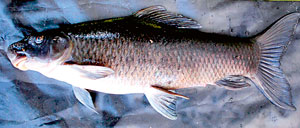While for three weeks blasts have been rocking the peaceful environs of Waratenna close to the Seemamalakaya on the Peradeniya-Katugastota Road, the sudden activity in connection with the groundwork for a mini-hydro power project has left the gadeya or Green Labeo (Labeo fisheri) dead, the Sunday Times learns.
The belief was that the gadeya was extinct worldwide, says researcher Pradeep Samarawickrama, explaining that about four months ago it was re-discovered by him at Waratenna. Earlier this fish was found in the Mahaweli system, at Polgolla and near Victoria, but with the construction of the dams under the accelerated Mahaweli Scheme, their habitats were submerged and changed.
| The Waratenna area in which the fish was found. Pix by Pradeep Samarawickrama |
“These sites should be preserved,” he stressed, without indiscriminate dynamiting of the rocks embedded in the riverbed.
Another serious concern that this researcher raised was the impact of such blasting in an area which is heavily landslide-prone, with the government on one hand requesting people to be cautious.
Adding his voice to the concerns expressed by Mr. Samarawickrama including the need to preserve the ‘last habitats’ of this nearly-extinct fish, environmental lawyer Jagath Gunawardena quoting Section 27 of the Fisheries and Aquatic Resources Act said that any act or negligence that causes the death of any fish by the use of explosives is an offence.
He questioned the integrity and inaction of the Mahaweli Authority, which being the project-approving body, has the responsibility of monitoring the implementation of the project that it had approved in the first instance.
Referring to the gadeya, Mr. Gunawardena said it was earlier found in areas such as Lewella, Tennekumbura and the lower regions of the Hulu Ganga but in the early 1980s it was predicted that 75% of the known habitats of this fish would go under water due to the construction of the Victoria reservoir.
“But now we realize the gadeya has been able to re-establish itself upstream,” he said.
He lamented that due to short-sighted policies, these areas too would be destroyed. “L. fisheri has been assessed as ‘endangered’ due to its restricted range (extent of occurrence less than 5,000 km2), continuing decline in habitat quality and the fact that the species is considered to be found in less than five locations,” according to the 2011 Global Red List of the International Union for Conservation of Nature (IUCN).
This species is found only in the mid to upper reaches of the Mahaweli Ganga basin, it states, explaining that L. fisheri may already be extinct, as a result of habitat loss following the Mahaweli Ganga development project.
Referring to habitat and ecology, the Red List states: “L fisheri is a benthopelagic species that only inhabits deep, fast-flowing sections of the river. It has not been recorded from unshaded, silty or turbid waters. It moves fast through the water, staying close to the bottom.”
It was way back in 1980 that Ranil Senanayake predicted that the Polgolla and Victoria projects of the Mahaweli Scheme would destroy the gadeya’s habitat while in 1990, Dr. Eric Wikramanayake said that this fish may already be extinct.
Bigger than originally believed
It was believed to grow only to 30 cm. but researcher Pradeep Samarawickrama has found a gadeya which is nearly twice that size, close to 60 cm. in length.Earlier, the known maximum length of this fish as reported by Dr. Paul Deraniyagala in his ‘Vertebrates of Ceylon’ Volume I published in the 1950s; the ‘Freshwater Fishes of Sri Lanka’ published by Rohan Pethiyagoda in 1991; and all other references was 30 cm.
However, a dead fish picked up by Mr. Samarawickrama is nearly twice that length.
Blasting going on despite warning
The company involved in the project has been warned to halt the blasting with immediate effect, said Mahaweli Authority Director-General D.M.C. Dissanayake who has sent a three-member inquiry team to the spot.I am waiting the report, he said. However, the Sunday Times learns from residents in the area that work has not been halted and the blasting was going on even yesterday, with the whine of backhoes dumping the blasted rock onto one side continuing throughout the day, aggravating the already disturbed habitat.
Meanwhile, Central Environmental Authority Chairman Charitha Herath said that the CEA has not given its concurrence for the latest work at that spot.
The CEA has asked all stakeholders including the company involved to come for an urgent meeting on Tuesday, he said, detailing the background to the Sunday Times.
In 2007, a proposal was put forward to set up a mini-hydro power plant there and environmental approval sought. The Mahaweli Authority as the project-approving agency set the terms of reference for an environmental impact assessment (EIA). The EIA was reviewed by the Mahaweli Authority and the CEA asked for concurrence and as there were no public comments it was given, says Mr. Herath.
The concurrence was for a three-year period from February 2007 to February 2010, during which time they were supposed to build the plant. However, the project was not started and the approval expired on February 2010. Recently, CEA concurrence was requested once again, but we have not given it. That’s why we called a meeting on July 26 to discuss it. However, we have received complaints that the project has been started.
Environmental lawyer Jagath Gunawardena, however, cites Section 24 B of the National Environment Act, according to which the CEA can issue a directive ordering the suspension of all activities of a project that is implemented without its permission. If this directive is not heeded the CEA can go to the Magistrate’s Court and get it implemented as a court order, he adds.
Source:http://www.sundaytimes.lk/110724/News/nws_69.html


No comments:
Post a Comment